

|
|
|
|
|
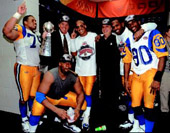 Jay Zygmunt, second from left, holding the trophy after the St. Louis Rams' triumph at Super Bowl XXXIV in 2000 Photo by Bill Stover 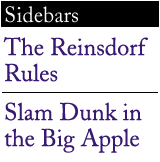
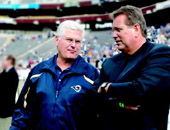 Zygmunt, right, conferring with Rams head coach Mike Martz in Phoenix last November. Photo by Bill Stover 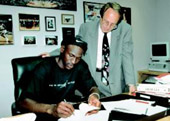 Irwin Mandel in 1995 with Michael Jordan as he signs a contract to return to the Chicago Bulls Photo by Bill Smith/Chicago Bulls 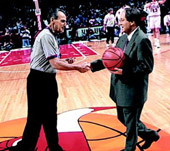 Mandel, right, moments after being honored in 1998 with the game ball for his long service to the Bulls Photo by Bill Smith/Chicago Bulls 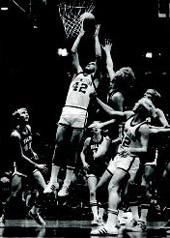 Wildcat Rick Sund in the mid-1970s Photo courtesy of Athletics Media Services 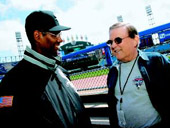 Eddie Einhorn, right, with White Sox manager Jerry Manuel early in this season Photo by Andrew Campbell 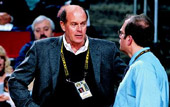 Sund of the Seattle SuperSonics with Mike Kahn of CBS.Sportsline.com this season Photo by Jeff Reinking/NBAE/Getty Images 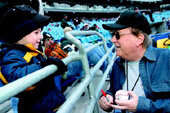 Einhorn at the chilly home opener at U.S. Cellular Field, engaging in some community outreach with a young fan Photo by Andrew Campbell 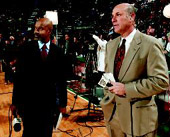 McKinney, left, with Kevin Calabro, the Sonics' color commentator, earlier this season Photo by Jeff Reinking/NBAE/Getty Images 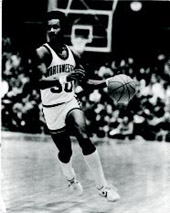 Billy McKinney making his move for Northwestern in 1976 Photo courtesy of Athletics Media Services 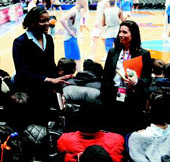 Browne Sanders talking to students from Brooklyn before a New York Knicks game in March against the Memphis Grizzlies Photo by MSG Photos 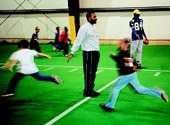 Ronbinson, center, with Randy Moss at the Vikings' African American Adoption Agency Christmas Party Photo by Rick Kolodziej |
 Kenesaw Mountain Landis (L1891), a graduate of Chicago’s Union College of Law (now the School of Law), once called baseball “a training field for life work.” Yet it took Landis more than three decades to assume the post for which he is best known today, nearly 60 years after his death — the first commissioner of organized professional baseball. He didn’t live long enough to see it, but that occupation also made Landis the torch-carrier for a still-growing alliance of Northwestern alumni who make their livings in professional sports management — owners, presidents, marketers and talent evaluators, to name a few, whose careers were often jump-started at the University and who flourish today in such major markets as New York City, Chicago, Minneapolis, St. Louis, Seattle and Toronto. “Because the sports business is a small, tight industry with few opportunities, timing is everything,” says Rick Sund (WCAS73), general manager of the National Basketball Association’s Seattle SuperSonics and an Academic All–Big Ten basketball player during his three years of eligibility at Northwestern. “When I speak to those wanting a career in sports, I tell them it often comes down to luck. It’s up to them to parlay that luck into the right opportunity.” Landis cut a meticulous vocational path through the field of law, never realizing that he was paving the way for a baseball career. His foray into baseball, as Sund suggests, came down to timing and luck. Landis rose from humble beginnings — he was a high school dropout — to become a U.S. district judge in Northern Illinois who once levied a $29 million fine against Standard Oil Co. Yet without baseball there would be no place for Landis in most U.S. history books. When eight Chicago White Sox players were accused of throwing the 1919 World Series, baseball leaders looked to the cantankerous 55-year-old jurist — who had a reputation for incorruptibility — for the stringent discipline needed to restore the faith of the sporting public. The judge wielded the absolute power that the owners granted him and banned the players for life, despite their acquittal in a court of law. Landis’ authority and the immense popularity of Babe Ruth aided baseball in getting back on track. During Landis’ 23 years of leadership, and on into the 1950s and 1960s, the sport reigned as this country’s undisputed national pastime. Landis’ passion and fortitude for the sport he loved, together with his Northwestern education, would set the tone for the growing numbers of University alumni that speckle the management side of the professional sports landscape from the hardwood to the gridiron, from Manhattan Island to Puget Sound. There’s the quintet of law school graduates: Jerry Reinsdorf (L60), owner and chair of both the Chicago Bulls and Chicago White Sox; Eddie Einhorn (L60), White Sox vice chair; Irwin Mandel (EB64, L67), Bulls’ senior vice president of financial and legal affairs; Jay Zygmunt (L78), president of football operations for the St. Louis Rams; and Glen Grunwald (L84), general manager of the NBA’s Toronto Raptors. And three former Wildcat basketball stars are integral parts of NBA offices: Sund in Seattle; Anucha Browne Sanders (C85), the New York Knicks’ senior vice president of marketing and business operations; and Billy McKinney (SESP77), the Sonics’ executive vice president and broadcast game analyst. Finally, there’s another alumnus who, like Zygmunt, is riding the National Football League’s currently enormous popularity wave: Jeff Robinson (SESP89), the Minnesota Vikings’ coordinator of professional personnel. “I carry Northwestern with me every day. I still look back at all that I learned and apply it,” says Robinson, a cornerback for the Wildcats from 1986 to 1988. “Playing football provided a solid foundation to understand sports, while academics helped with the business side. Both of my parents are teachers, and they always said that I had to be prepared if playing football didn’t work out.” Though he used his college playing career as a stepping stone to the Vikings, Robinson relied on his classroom smarts to rise within the organization. Recruited to play at Northwestern out of his hometown of Minneapolis, Robinson left the University with aspirations for an NFL career, but when a ground-floor opportunity arose in the Vikings’ public relations office, Robinson took it and bypassed the possibility of gridiron glory. “Once I knew I would stay with the Vikings, I let them know I wanted to work more closely with the players,” Robinson recalls. “There is low turnover in this business, and everyone wants to do it. It’s been more of a quiet evolution for me than a master plan.” Fourteen years later Robinson has advanced to become second in command in the Vikings’ personnel office, where his duties include league-wide player evaluation, scouting of opponents and co-managing the team’s 69-man roster. If Robinson were to peer into a crystal ball, he might see a future for himself similar to Zygmunt’s present. The Rams’ president of football operations is known throughout the NFL as a “salary cap whiz” for his ability to manage the league-imposed rules on how much a team can spend on its players. Zygmunt is also a master in managing a team’s personnel, helping to assemble a collection of draft choices and free-agent signings in the 1990s — including the rescue of an unknown quarterback named Kurt Warner from the scrap heap — that would lead St. Louis to victory in the 2000 Super Bowl. Today the personnel side of sports is an even tougher nut to crack than it was in 1979 when the 27-year-old Sund was named player personnel director for the NBA’s Dallas Mavericks. Under his leadership the franchise had eight consecutive years of improved win-loss records. Sund once had hoped to play in the pros, but he went undrafted by the NBA and accepted a postgraduate scholarship in sports management at Ohio University. Following his studies Sund worked for four years in the Milwaukee Bucks’ front office before the Dallas job became available. “Between the scholarship and the opportunity in Milwaukee, I was groomed to be in sports management,“ says Sund, whose deals during the first half of the 1980s netted Dallas nine first-round draft picks, including Mark Aguirre, Rolando Blackman, Sam Perkins, Derek Harper, Roy Tarpley and Detlef Schrempf. “I went from running summer camps and keeping player files to, four years later, talking on the telephone with Red Auerbach [the legendary coach and general manager of the Boston Celtics]. I was truly thrown into the fire at a young age.” Browne Sanders’ trials by fire took place during the early professional years she spent in the business world, when she continuously approached her job with the same tenacity she brought to the basketball court during her years at Northwestern. One of the top collegiate players in NCAA women’s history (see sidebar), the Knicks’ Browne Sanders spent 11 years with IBM, the first six as a technology salesperson and the last five with the organization’s sports marketing branch. She represented the company at three Olympic games — Atlanta in 1996, Nagano, Japan, in 1998 and Sydney in 2000 — and then the New York Knickerbockers came calling. “In one of my first interviews out of college, I was told, ‘You have the marketing and communications experience. You need business experience,’” says Browne Sanders in her Madison Square Garden office in midtown Manhattan. “IBM made for a nice transition into the NBA.” Now in her third year with the Knicks, the New York native manages a staff of 20 and oversees the business side of the team, including community relations, field marketing, fan development, corporate and ticket sales and budgeting. Like Browne Sanders and Sund, McKinney was a Wildcat basketball star as well as a two-time All-American (1976 and 1977). He followed a course similar to his Seattle colleague, starting when he broke Sund’s Northwestern scoring record. “My mother raised six of us kids on a sixth-grade education,” says McKinney, the first and only child in his family to go to college. “She stressed the importance of education and to never put all my eggs in one basket. I had success in basketball, but I never wanted to be perceived as just a basketball player. I not only went to school, I went to one of the best schools in the world. My education prepared me to do anything I wanted to do.” McKinney played nearly seven years in the NBA for teams in Kansas City, Utah, Denver, San Diego and Chicago. He retired as a Bull in 1985 to join the front office as a 29-year-old assistant general manager. Three years later he was named director of player personnel for the expansion Minnesota Timberwolves before moving to Detroit in 1992 as director of player personnel with the Pistons. Three years later Seattle named McKinney its top scout of high school, college and overseas talent. He traveled the globe 100,000 miles annually to watch basketball games. When a group led by Starbucks’ chair Howard Schultz purchased the Sonics in 2001, Sund became general manager and McKinney was promoted to executive vice president. A coveted motivational speaker, McKinney also serves as the team’s color analyst for television and radio broadcasts. “I’ve done everything a person can do in this league other than be a head coach,” says McKinney. “I was considered a journeyman player, but I’m proud that I started a trend in my generation of African Americans making strides in management roles.” This is the 30th year with the Bulls for Mandel, a native Chicagoan who is responsible for the team’s financial, legal and corporate affairs. His launching pad to the NBA consisted of four years in Arthur Andersen’s tax department, which concluded after he provided the Bulls’ new owners with a sparkling 100-page purchase investigation report. “It took several months, and all the while I hoped and prayed they would hire me full time. And they did,” says Mandel, who has watched everyone from Bob Love to Jerry Sloan to Michael Jordan lace them up for the Bulls. Mandel is also part of a select group of NBA executives who advise the league’s office on the salary cap, configured to maintain competitive balance and not allow teams with deeper pockets to outspend the others for free-agent players. “Without my Northwestern degrees, I seriously doubt I’d be working for the Chicago Bulls today,” he says. “The degrees allowed me to combine my backgrounds in law, accounting and taxes with the field I love — sports.” Like Mandel, Reinsdorf and Einhorn used law degrees, not playing experience, to cross the sports-as-business threshold. Law school classmates, the two went their separate professional ways before reuniting in 1981 to buy the Chicago White Sox (see sidebar). That season’s Sox club was managed by Tony LaRussa, the current St. Louis Cardinals’ manager, and captained by Hall of Fame catcher Carlton Fisk. “Northwestern allowed me to meet Jerry,” says Einhorn from his home in New Jersey. “It also broadened my thought process. I really don’t think I would have thought the same, done the same or been the same without it.” Reinsdorf remains majority owner of both the White Sox and the Chicago Bulls, which he purchased in 1985. That was an auspicious time, being the end of Jordan’s rookie year. Einhorn, who served as the Sox president for a decade, is renowned for his work in sports television and was the chief architect of Major League Baseball’s first billion-dollar television contract. Einhorn most likely speaks for all of these alumni in acknowledging that the electronic media have completely transformed all aspects of professional athletics. “Television is the fuel that has exposed sports to more people,” he says. “But maybe it’s grown a little too much. Television has provided the money that’s made sports too big and a bit too important. And all the excesses of big business have gotten attached to it.” Multimillion- and billion-dollar deals are now commonplace in baseball, football and basketball. Nonetheless, says Sund, television revenues represent only a portion of the magnitude of changes his sport has undergone in the last quarter-century: “It’s been dramatic, in a word. We’ve gone from a thousands-per-year industry to millions to billions. Front offices used to have five or 10 people; now we have hundreds of staff members. Per diems [for athletes’ routine expenses] were $28 a day, now they are $100. The minimum salary was $28,000 [in 1979]. Now it’s $1 million.” In McKinney’s playing days most teams took commercial flights rather than the cozy private charter jet aircraft of today. Players rose early to wait at the airport. Seven-footers curled their legs to their chests to fit in standard airplane seats. “Basketball was a nine-month sport, where today it’s year-round,” says McKinney. “That means more and more people are needed to keep a franchise running smoothly.” On Mandel’s first day in the NBA just seven people worked in the Bulls’ front office. Now there are more than 50. Then, the basketball office featured a head coach, assistant coach, general manager and trainer. Today it employs a head coach and four assistants, an advance scout, a trainer and assistant trainer, a strength and conditioning coach and assistant strength and conditioning coach, an equipment manager, two orthopedic surgeons, a podiatrist and even four dental consultants. The Bulls in their inaugural season of 1966 had an entire team payroll of $250,000. The salaries for individual Bulls players in 2003 average $4 million, 16 times per player what all 12 on the squad made combined in that first year. “Of course, the club’s national TV money was $350,000 when I started,” says Mandel, who signs his team’s payroll checks. “Now it’s $25 million.” Einhorn, who once broadcast Northwestern football games on WEAW-AM in Evanston and started a national radio service that showcased college basketball from his residence hall room, says the inevitably higher ticket costs are bound to have a ripple effect on future generations of fans. “People just don’t want to pay $90 to go to a hockey game or $500 to go to a Super Bowl,” he says. “Higher ticket prices could hurt a sport like baseball, which has always been passed on from generation to generation. Although there are still ways for people to go to games, they can’t go as often and they can’t take their families as frequently.” While the average fan is quick to opine that pro athletes’ salaries are far out whack compared with the ticket-buying public that helps pay their salaries, Robinson sees both sides of the equation and makes a good case for the players. “The problem is perception,” says Robinson, whose Vikings are paying wide receiver Randy Moss $75 million over eight years. “People never seem to think of an actor or actress who makes $10 million a picture as being overpaid. In the NFL the average player is out of the league after 3.3 years. That doesn’t leave a lot of time to make their money. I think they earn every cent.” From McKinney’s perspective the high salaries also make managing the players more difficult. “It used to be a baseball bat theory: Management spoke, and it happened,” he says. “Now the players are basically small companies. They have guaranteed contracts, and some of them make 20 times more than we do.” As an owner who paid the Bulls’ Jalen Rose $12 million in the 2002–03 season and will shell out more than $50 million to Frank Thomas, Magglio Ordonez and the rest of the White Sox this summer, Reinsdorf has said that athletes have supply and demand in their favor — especially when it comes to the frequently made comparison with teachers’ salaries. “There is a small supply of athletes who have the ability to play at the major league level in any sport, and the demand is great enough that they command these salaries,” he once told the Chicago Tribune. “There’s a demand for teachers, but it comes with an equal supply.” Making a lot of money in the world of professional athletics, however, is a two-way street. It’s no coincidence that increased paychecks have emerged at the same time as increased sports marketing — jerseys, video games, bobblehead dolls, autograph signings and players crossing over from sports to the entertainment industry. “In the National Basketball Association there is a lot more concentration on branding, both as a league and at the individual team level,” says Browne Sanders. “Getting the brand out there is vitally important, and there is a much larger marketing budget because of it.” Deion Sanders, a two-sport star in football and baseball during the 1990s, is often credited with creating the off-the-field endorsement impact of the modern athlete. But Robinson, whose Vikings employ one of the NFL’s most marketable stars in Moss, adds that the teams and leagues give these athletes their star power. “The focus on marketing has skyrocketed, and it’s evident everywhere you look,” he says. “It got to where if you didn’t jump on, you’d miss something. And the NFL jumped on. There is sound leadership in marketing league-wide. Football is now an international game.” Major League Baseball and National Basketball Association games are also beamed across the globe, and thanks to foreign stars such as Japan’s Ichiro Suzuki of baseball’s Seattle Mariners and China’s Yao Ming of basketball’s Houston Rockets, prospective athletes from every continent are well aware that all the world’s a stage for them to show off their skills. “I travel with an NBA team, and the degree of the celebrity status of some guys almost makes me uncomfortable,” says McKinney, who spent two years on the road with Sonics’ star guard Gary Payton (traded to the Milwaukee Bucks in February). “I played with Michael Jordan, and I can’t even imagine what it’s like being him. It’s like being in the Macy’s window in New York City. You can’t do anything. And in this day and age, security concerns are an issue.” Babe Ruth was a celebrity in his era. So were Joe DiMaggio and Mickey Mantle. Still, Einhorn notes, it was a different kind of celebrity than one finds in today’s mass media age. “Our society feeds on celebrity,” he says. “People are curious about the lives celebrities lead. They look up to them, and many celebrities just go with that lifestyle.” As one of the NBA’s leading marketers, Browne Sanders notes that players deserve credit for their fame and fortune. “If they weren’t incredible athletes, they wouldn’t have a leg to stand on,” she says. “Celebrity comes from the outside influences that their playing creates. But people come out to see them because they are simply phenomenal talents, and they work their tails off.” Star athletes from Mandel’s childhood — baseball’s Willie Mays, football’s Johnny Unitas and basketball’s Bob Cousy — were viewed as heroes. And although the fame and money today far exceed the rewards of the old days, the Bulls’ Mandel says it all comes with a price. “[Basketball star] Charles Barkley once said that athletes are not role models,” Mandel says. “Whether they believe they should or should not be, they do in fact serve as role models because they do influence the kids who look up to them.” The Sonics’ McKinney agrees with Mandel that youngsters look up to the players but disagrees with the notion that they should. “Just because you’re good at something — whether it’s music or sports or whatever — that doesn’t equate to being a good person,” he says. “My role models were never pro athletes. They were my teachers and coaches and my mother.” NBA role models come, and they go. From Wilt Chamberlain to Kareem Abdul-Jabbar to Larry Bird, the NBA has undergone smooth fan-base transitions from generation to generation. Sund marvels at the aura of a 21st-century basketball crowd. “When I started in Dallas, the NBA wasn’t as popular,” he says. “People weren’t going to a lot of games there or anywhere. But by the time I left Dallas, there were sellouts all over.” With the 1990s came corporate seating and luxury suites, aimed at raising money to meet the financial demands of players and management. Like other sports leagues, the NBA saw the modern arena as a key ingredient to building revenue. “Since I started in 1979, only Madison Square Garden remains as an original arena,” notes Sund as he considers every NBA franchise. “All the other 29 teams have new or renovated homes.” Robinson says the 1998 Vikings — who went 15-1 with former Northwestern head football coach Dennis Green leading a host of all-star players including Moss and future Hall of Fame wide receiver Cris Carter — brought the once-proud franchise back to life. “It’s been a real evolution,” Robinson says. “We still have the same basic younger, blue-collar audience, but it’s incorporated more middle-to upper-class fans. You mix them all together, and it makes for a rowdy atmosphere.” During the Bulls’ six-year championship run, their stars — Jordan, Scottie Pippen and Dennis Rodman — were welcomed like the Beatles in visiting cities, and there were no more raucous home courts than the old Chicago Stadium and the United Center, which replaced it in 1994. Mandel says the team’s success created a larger fan base, one that he believes has stayed loyal during the Bulls’ recent rebuilding phase. “The tremendous following that took hold when Michael Jordan was here remains,” he says. “Our fans are very optimistic about our future, and we have a tremendous marketing staff that services them very well.” Loyal as they may be, there also may be no fans more critical of their team than New York fans. But Browne Sanders says those who follow the Knicks have a sense of history like no one else. “When I talk to fans, they always mention their first involvement with the team,” she says. “They remember going to a game with their dad or seeing a game-winning shot.” Yet Browne Sanders, whose Knicks’ rosters have featured popular NBAers Patrick Ewing, Allen Houston and Latrell Sprewell, understands that ticket buyers are paying for more than just the athletes. “They want to know that the front office, the organization and the players have character and that they are giving back to the community,” she says. “They want to see what the organization stands for. They are buying the entire package.” That package — which includes the club owners right down to the last players on the bench — is not as simply defined in 2003 as it was in the past. With the increased presence over the last two decades of player agents — whose job it is to earn the maximum value for the players who hire them — management has had to weed through yet another layer in the communication process. “It used to be that you could sit down and have a dialogue with a player,” Einhorn says. “Jerry [Reinsdorf] and I used to have closer relationships with the players. It’s not as easy to do that anymore.” Unlike football contracts, which management can void any time a player sustains an injury or simply suffers dimished ability, baseball and basketball contracts are guaranteed. Most teams are willing to pay for productivity, but they are leery of guaranteeing long-term money to an older player or to one with failing health or off-court problems. Yet, according to Mandel, there’s a fine line between the two goals. “If you don’t want to pay your player, there might be another team that will,” he says. “Therefore, if you want to be competitive, you have to be smart, but you also have to be willing to pay for quality. It’s hard for some teams when players get the large contracts and lose their hunger. Fortunately, most do not. Also, the collective bargaining agreement [the player/management deal] allows the league to tell the players, ‘The better we do, the better you do.’” McKinney adds that the new financial setup also creates other demands. “You have to be more than a manager,” he says. “You must be a communicator, a motivator and a therapist. Because there’s a third party involved [agents], sometimes that message can get confused. “Agents have changed sports, but so have the media. With advertising comes the pressure of selling the game. And with that pressure comes pressure for management to run a team. It’s far more significant than it was even 15 years ago. Your whole life is in a fish bowl.” Managing the basketball side in Seattle, where seafood is supreme, Sund is indeed the kingfish. But he says all the player relationships, team transactions and day-to-day duties come down to a single characteristic: communication. “If you can’t communicate or manage people, you will fail in this business,” he says. “In the course of one day, I talk to my owner, to the CEO, coaches, agents, players, front office and media. I have to keep everything focused in the same direction. Northwestern was a blue-book final for that every day that I was there.” Credit to their former university for providing the education that lit their sports management fuse comes from the other executives as well — and most likely, somewhere, from the old judge himself. |